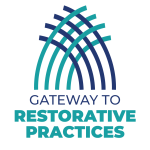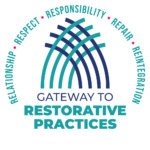
If you are working with Restorative Practices in Schools then you know that there are not as many resources for working with elementary children as there are for junior and senior high students. I discovered a booklet focused on 9 to 12 year olds by Professor Rick Kelly from George Brown College in Canada that is available to print online.
Principles
Although Completing the Circle: Conferencing for Children at Risk was published in 2004, the principles are relevant today. Kelly’s focus is on children under age 12. What I found refreshing and unique is his perspective on how some child development theories align developmentally with Restorative Justice Conferencing (RJC).
Vygotsky
Child development theorist Lev Vygotsky believes children’s learning is enhanced when an adult provides “scaffolding” (or support) near to the child’s developmental ability. This expands their capacity which results in the child’s development being enhanced and supported.
Developmental Areas
Kelly also identifies a number of developmental areas children experience between the ages of 9 to 12. Children are beginning to not only understand their own perspective, but the perspective of others. They are learning to determine the difference between what is right and what is wrong. Additionally, they are responding to the feelings of others. They are motivated by positive expectations, encouragement from others, and reinforcement.
Foundation
These developmental concepts lay the foundation for children ages 9 to 12 to participate in a valuable strategy known as Restorative Justice Conferencing. This structured method brings together each person harmed by the student(s) who caused the harm and is typically facilitated by a school administrator. Causes of harm in an elementary school could be bullying, fighting, damage to property, cheating or stealing.
Voluntary
Restorative Justice Conferencing requires voluntary participation by all those affected by a problem. The focused goal is repairing the harm. Students are held accountable for their actions and making things as right as possible.
Support Needed
Sometimes students invite a peer friend and other adults to support them. Parents/guardians often participate in this collaborative approach. Conferencing is an excellent method for engaging parents and families. Parents often see this as a way for their students to resolve problematic behaviors, face consequences, and become more assertive.
Effectiveness
“Restorative Justice Conferencing has been seen to be effective when used with a variety of different behaviors, in a variety of settings, with diverse cultural groups and with different age groups. A growing body of experiences and research is demonstrating the effective[ness] of such an approach as an early intervention with children under 12” (p. 7).
To learn more about conferencing with children under 12, please read Professor Kelly’s work.
Source:
Completing the Circle: Conferencing for Children at Risk, Rick Kelly, Professor, Child and Youth Worker Program, Centre for Community Services and Development, George Brown College in Canada, 2004.
http://justusrestorativepractices.weebly.com/uploads/8/7/9/9/8799956/manual.pdf.

